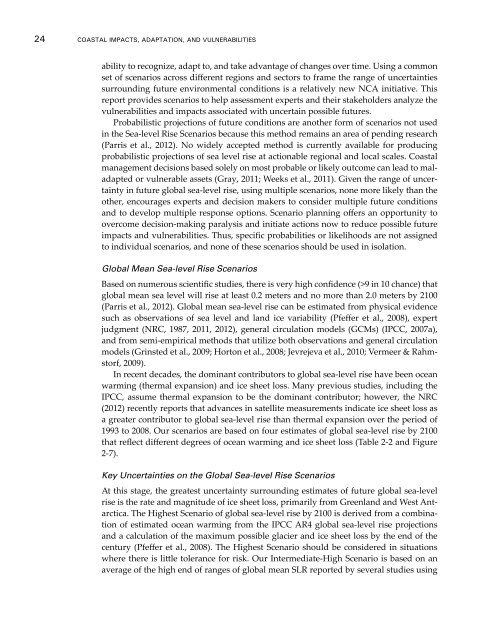Coastal Impacts, Adaptation, and Vulnerabilities - Climate ...
Coastal Impacts, Adaptation, and Vulnerabilities - Climate ...
Coastal Impacts, Adaptation, and Vulnerabilities - Climate ...
Create successful ePaper yourself
Turn your PDF publications into a flip-book with our unique Google optimized e-Paper software.
24 <strong>Coastal</strong> <strong>Impacts</strong>, <strong>Adaptation</strong>, <strong>and</strong> <strong>Vulnerabilities</strong>ability to recognize, adapt to, <strong>and</strong> take advantage of changes over time. Using a commonset of scenarios across different regions <strong>and</strong> sectors to frame the range of uncertaintiessurrounding future environmental conditions is a relatively new NCA initiative. Thisreport provides scenarios to help assessment experts <strong>and</strong> their stakeholders analyze thevulnerabilities <strong>and</strong> impacts associated with uncertain possible futures.Probabilistic projections of future conditions are another form of scenarios not usedin the Sea-level Rise Scenarios because this method remains an area of pending research(Parris et al., 2012). No widely accepted method is currently available for producingprobabilistic projections of sea level rise at actionable regional <strong>and</strong> local scales. <strong>Coastal</strong>management decisions based solely on most probable or likely outcome can lead to maladaptedor vulnerable assets (Gray, 2011; Weeks et al., 2011). Given the range of uncertaintyin future global sea-level rise, using multiple scenarios, none more likely than theother, encourages experts <strong>and</strong> decision makers to consider multiple future conditions<strong>and</strong> to develop multiple response options. Scenario planning offers an opportunity toovercome decision-making paralysis <strong>and</strong> initiate actions now to reduce possible futureimpacts <strong>and</strong> vulnerabilities. Thus, specific probabilities or likelihoods are not assignedto individual scenarios, <strong>and</strong> none of these scenarios should be used in isolation.Global Mean Sea-level Rise ScenariosBased on numerous scientific studies, there is very high confidence (>9 in 10 chance) thatglobal mean sea level will rise at least 0.2 meters <strong>and</strong> no more than 2.0 meters by 2100(Parris et al., 2012). Global mean sea-level rise can be estimated from physical evidencesuch as observations of sea level <strong>and</strong> l<strong>and</strong> ice variability (Pfeffer et al., 2008), expertjudgment (NRC, 1987, 2011, 2012), general circulation models (GCMs) (IPCC, 2007a),<strong>and</strong> from semi-empirical methods that utilize both observations <strong>and</strong> general circulationmodels (Grinsted et al., 2009; Horton et al., 2008; Jevrejeva et al., 2010; Vermeer & Rahmstorf,2009).In recent decades, the dominant contributors to global sea-level rise have been oceanwarming (thermal expansion) <strong>and</strong> ice sheet loss. Many previous studies, including theIPCC, assume thermal expansion to be the dominant contributor; however, the NRC(2012) recently reports that advances in satellite measurements indicate ice sheet loss asa greater contributor to global sea-level rise than thermal expansion over the period of1993 to 2008. Our scenarios are based on four estimates of global sea-level rise by 2100that reflect different degrees of ocean warming <strong>and</strong> ice sheet loss (Table 2-2 <strong>and</strong> Figure2-7).Key Uncertainties on the Global Sea-level Rise ScenariosAt this stage, the greatest uncertainty surrounding estimates of future global sea-levelrise is the rate <strong>and</strong> magnitude of ice sheet loss, primarily from Greenl<strong>and</strong> <strong>and</strong> West Antarctica.The Highest Scenario of global sea-level rise by 2100 is derived from a combinationof estimated ocean warming from the IPCC AR4 global sea-level rise projections<strong>and</strong> a calculation of the maximum possible glacier <strong>and</strong> ice sheet loss by the end of thecentury (Pfeffer et al., 2008). The Highest Scenario should be considered in situationswhere there is little tolerance for risk. Our Intermediate-High Scenario is based on anaverage of the high end of ranges of global mean SLR reported by several studies using
















